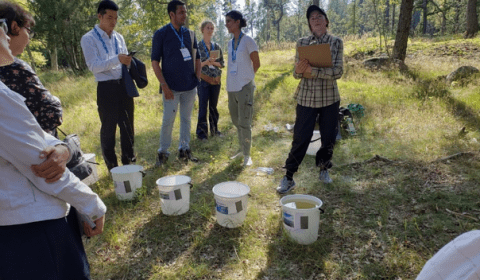Connecting to the Forest at World Water Week in Stockholm, Sweden


“Allemansrätt,” the Right of Public Access, allows everyone to freely roam the forests and fields of Sweden’s countryside regardless of ownership. Swedes, as well as visitors, can freely hike, bike, ride, and even camp in Sweden’s natural spaces. Since over 70% of Sweden is covered by forest, there is a lot of land that is waiting to be explored. It is unsurprising, then, that Swedes have a unique connection to their outdoor spaces.
During World Water Week, I attended a field trip to a forest near Stockholm in a session titled “Engaging People in Forest and Water Management.” The session provided a hands-on experience with Swedish forest education and forestry management techniques.
After arriving at the forest, we were given a demonstration of “forest school.” In Sweden, it is not uncommon for teachers to take their students outdoors to learn about and play in nature. The first presenter of the session then showed us an example of an interactive lesson that she often gives to schoolchildren about the distribution of the Earth’s water. In front of her were five empty buckets representing different aspects of the hydrosphere. With one full bucket representing all the water on the Earth, she distributed it into the other buckets. A single drop of water went into the “atmosphere” bucket and some tiny spoons were used to distribute the water into the “glacier,” “lakes and streams,” and “groundwater” buckets. Finally, she dumped the remainder of the water into the “ocean” bucket and explained that with so few freshwater resources, it is important that we maintain them. This visual and interactive example, she said, helped students grasp the importance of environmental protection.

She then turned us loose to explore the forest, like a teacher would with a class. With some jars, a couple pairs of fishing waders, and the same enthusiasm as schoolchildren let loose in a forest, we explored the stream we had been standing near, where I was able to catch a caddisfly larva that I proudly showed off to anyone else at the session who was willing to listen.
Next, we learned about Swedish “blue targeting,” a technique used by Swedish foresters to determine what actions to take near riparian zones. With just a pen and paper, foresters tally up different aspects of the environment on a form in order to determine what considerations should be taken when harvesting the timber. We walked a stretch of the stream ourselves and filled out the form, gaining firsthand knowledge of how simple the system is to use. With a simple checklist and little training, foresters can harvest timber from an area without destroying ecologically or culturally important riparian zones.
Forests play a large economic and cultural role in Sweden. This session at World Water Week demonstrated how Sweden is working to connect its people to the forest and protect the country’s natural resources.
Personally, I think the Swedes are onto something: I’ll take a forest over an indoor classroom any day.

